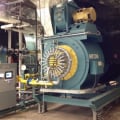Welcome! Here are the website rules, as well as some tips for using this forum.
Need to contact us? Visit https://heatinghelp.com/contact-us/.
Click here to Find a Contractor in your area.
If our community has helped you, please consider making a contribution to support this website. Thanks!
ASME CSD-1 (2009) CE 110 (c)
Options
electriKyle
Member Posts: 4
Not sure of the intent of the aforementioned code requirement. If the remote shut off or the disconnect fails? The fuel supply to the boiler has to shut down. Fails how? Short circuit? Ground fault? Failure for switch to make contact
what is the intent here and how is this supposed to be implemented?
what is the intent here and how is this supposed to be implemented?
0
Comments
-
@electriKyle
I think what they are talking about is ASME want's emergency switches at every boiler room entrance. So 2 entrances, switches, 1 entrance 1 switch
These are manual switches used to shut equipment down in an emergency. The switch has to shut of the burner(s) and the fuel supply by closing gas valves shutting off oil pumps and or solenoid valves.
Other than that switch failing??? don't know what you mean0 -
There has to be an “emergency” switch at each entrance to the boiler room. If there are three entrance, there must be three switches.
If the door opens to the interior of the building, the switch must be on the outside of the door. If the door opens to the exterior of the building, the switch must be inside the door.The switch does not have to directly shut off a gas valve or oil pump etc. It needs to cause the boiler to turn off or shut down in a way that shuts the fuel off.
So you can wire the emergency switch(s) into the limit circuit of your boiler/burner. On smaller residential stuff or even small commercial stuff that is only 120v, you could wire the switches to shut power off completely to the boiler.Never stop learning.0 -
So milivolt systems usually don't meet that requirement.0
-
CE-110 (c) indicates:
“ the electrical equipment shall be arranged so that the failure of this equipment will cause the fuel supply to be shut off”
what does that mean
Boiler inspector quoted it after his walkthrough at the Hotel I designed said he will allow fire alarm smoke, heat, and water flow to shut down boiler in lieu of meeting this requirement
thanks ahead of time
ElectriKyle0 -
By the way it’s not the remote shut off requirement, that’s CE-110 (a)... and we meet that requirement on this project (the inspector had no issues with where the remote shut offs were placed)
0 -
Could it mean that no power will be needed to shut down burner.
It would shut down automatically with loss of power.
No normally open gas valves, never heard of one. Other than the block-vent-block type of gas train.0 -
@electriKyle
I think he is interpreting something that is already built into the equipment.
With today's equipment for instance if a boiler goes off on flame failure the gas/oil will be shut down and that would require a manual reset. If it goes off on high steam pressure or high hot water temp or low water cutoff all the commercial jobs now have manual reset safety controls on them which will shut the burner down and close all the fuel valves
So it's built into the equipment in my view0 -
@mattmia2
Good point on the millivolt. I have gone into houses with no switch on the boiler...no way to even shut the system off unless you disconnect a wire or shut the gas off or the thermostat
We have some people wanting to install millivolt. I thought they could only be used for replacement because the gas valve only has one valve in it. Maybe @Tim McElwain will respond0 -
I thought that there were some total shutoff millivolt valves but they are less common because most things were switching to 24 vac controls around that time.0
Categories
- All Categories
- 87.3K THE MAIN WALL
- 3.2K A-C, Heat Pumps & Refrigeration
- 61 Biomass
- 429 Carbon Monoxide Awareness
- 120 Chimneys & Flues
- 2.1K Domestic Hot Water
- 5.8K Gas Heating
- 115 Geothermal
- 166 Indoor-Air Quality
- 3.7K Oil Heating
- 77 Pipe Deterioration
- 1K Plumbing
- 6.5K Radiant Heating
- 395 Solar
- 15.7K Strictly Steam
- 3.4K Thermostats and Controls
- 56 Water Quality
- 51 Industry Classes
- 50 Job Opportunities
- 18 Recall Announcements
